Understanding CMMI
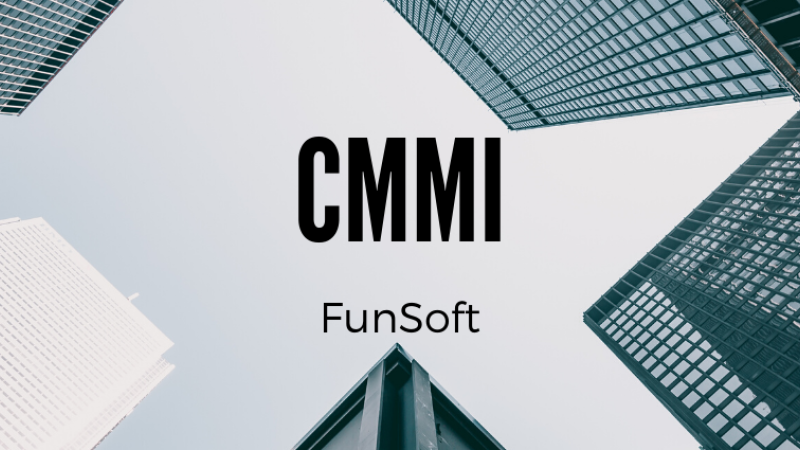
Do you want your high-performance organization to achieve demonstrable sustainable improvements? Then you have come to the right blog.
The Capability Maturity Model Integration (CMMI) is a model that evaluates the practices of an organisation to see how efficient they are. It provides a clear definition of what an organisation should do to promote behaviors that lead to improved performance, productivity, and decreasing risks in product and service development, management, and acquisition.
In simple words, we could say CMMI evaluates and makes your business processes effective.
Now, what’s its main goal?
The CMMI’s objectives for businesses include enabling the organization to produce quality services or products; increase customer satisfaction; increase value for stockholders; achieve industry-wide recognition for excellence; build a larger market share.
This short video, made by the CMMI Institute, shows in a simple way how the ship of your business can overcome even the most aggressive waters when applying CMMI.
A little bit of history…
Actually, since its formation in 1984, CMMI has gone through adjustments. It has continued to gain popularity in the development industry. Today, it is one of the most famous models.
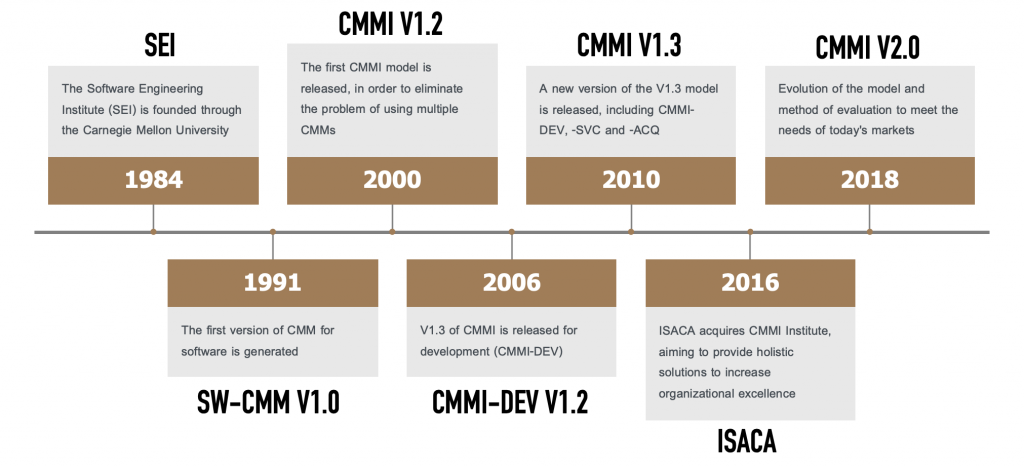
CMMI V2.0
Over time, CMMI has changed primarily in an effort to make models easier for businesses to understand and implement. CMMI V2.0 Key Improvements are:
- Improve Business Performance: Business goals are tied directly to operations in order to drive measurable, improved performance against time, quality, budget, customer satisfaction, and other key drivers.
- Leverage Current Best Practices: CMMI V2.0 is a trusted source of proven best practices that will be continuously updated to reflect changing business needs on the new online platform.
- Build Agile Resiliency and Scale: Direct guidance on how to strengthen agile with SCRUM project processes with a focus on performance.
- Increase Value of Benchmarking: New performance-oriented appraisal method improves reliability and consistency of benchmarks while reducing preparation time and lifecycle costs.
- Accelerate Adoption: Online access and adoption guidance make the benefits of CMMI more accessible than ever.
The CMMI helps us understand the answer to the question “how do we know…?”:

- How do we know what we are good at?
- How do we know if we’re improving?
- How do we know if the process we use is working well?
- How do we know if our requirements change process is useful?
- How do we know if our products are as good as they can be?
Now that we understand what the CMMI does, let’s discover how it works!
CMMI starts with an appraisal process that evaluates three specific areas:
- Process and service development (CMMI-DEV)
- Service establishment and management (CMMI-SVC)
- Product and service acquisition (CMMI-ACQ)
Usually going through a CMMI study is expensive as it is the sum of different factors: it can cost anywhere from $36k to $60k. However, for big enterprises, this price is not such a problem.
Of course, going through the appraisal process can be time-consuming and expensive for organizations, but we must remember that doing so provides several benefits.
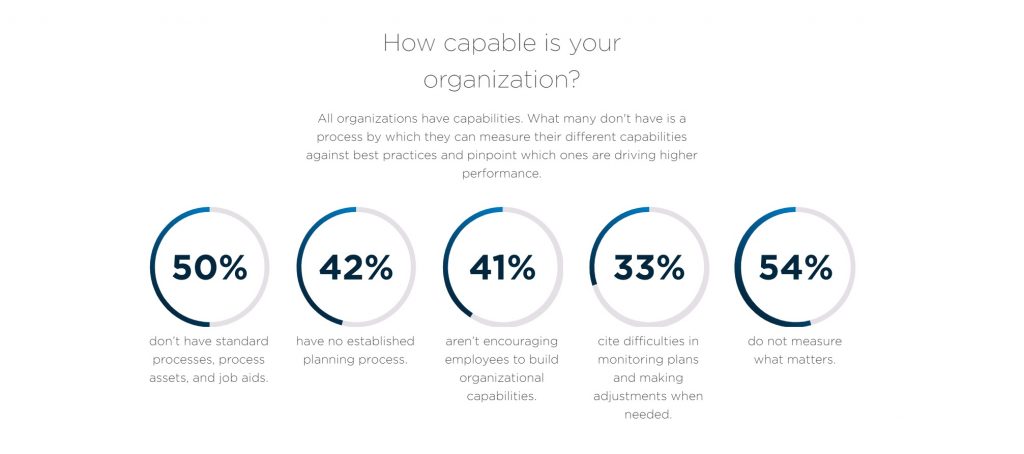
Any appraisals using the CMMI model must comply with the requirements in the Appraisal Requirements for CMMI (ARC) document. The official appraisal method used by the CMMI Institute is known as the Standard CMMI Appraisal Method for Process Improvement (SCAMPI). Within this approved method, there are three classes of appraisal methods:
SCAMPI Class A is the most formal and rigorous type of appraisal it provides a benchmark for businesses and is the only level that results in an official rating. Organizations that conduct this type of appraisal usually have already implemented a number of changes and need to benchmark their progress formally.
SCAMPI Class B appraisals are primarily used by organizations that have implemented some changes and want to measure their progress towards targeted CMMI levels. This appraisal is less formal than SCAMPI A; it helps businesses get a better idea of where they stand in the maturity process without having an official rating.
SCAMPI Class C appraisals are less expensive, quicker, and more flexible than either Class A or Class B appraisals. The goal of this type of appraisal is to quickly assess a business’s practices and determine how they align with CMMI best practices.
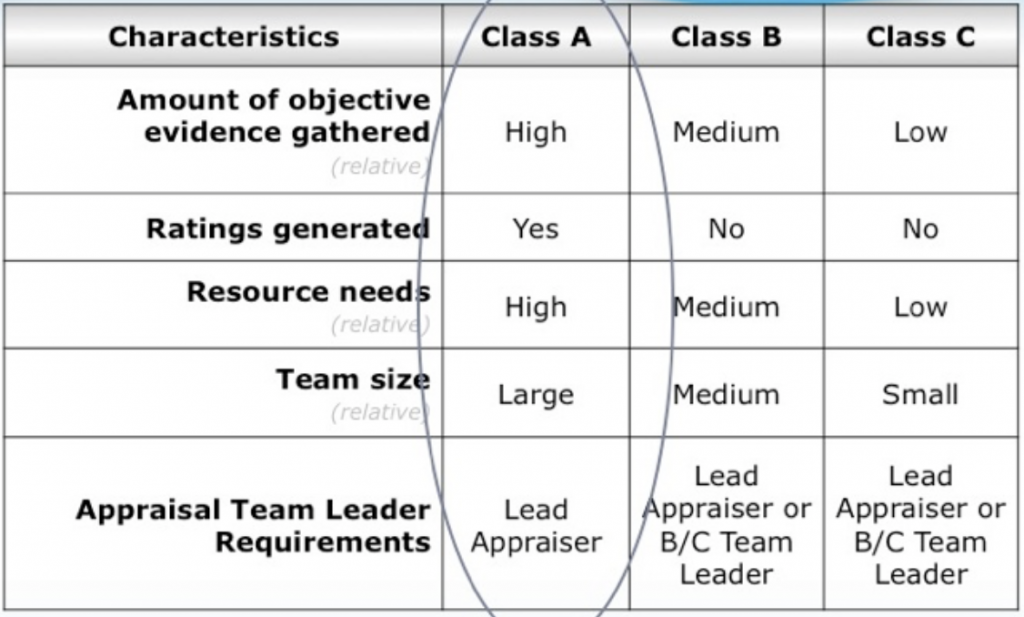
How are organizations rated by the CMMI?
When a Class A appraisal is done, an organization is awarded either a maturity level rating or a capability level rating. Maturity level ratings range from 1 to 5, with level 5 being the highest level and the goal towards which organizations are working.
The five CMMI maturity levels are:

In order to reach a specific maturity level, organisations must have implemented the corresponding 22 processes to their businesses:
- Project Planning (PP): set of practices that are important for any business, project plan preparation, scheduling, risk planning, etc.
- Project Monitoring and Control (PMC): Used as guidance it helps monitoring through progress reviews and milestone reviews.
- Configuration Management (CM): provides guidance for identification of configuration items, control of configuration, etc.
- Integrated Project Management (IPM): helps in setting up and managing the project with the involvement of all the stakeholders.
- Measurement and Analysis (MA): guidelines for development and sustained measurement which eventually helps the decision making process.
- Process and Product Quality Assurance (PPQA): great way to maintain the quality of relevant processes and other products
- Decision Analysis and Resolution (DAR): great way to select one of the best alternative using evaluation techniques.
- Quantitative Project Management (QPM): is used for advanced measurement and assist in quantitative control and overall improvement of objectives
- Risk Management (RSKM): assists businesses in identifying potential problems before they occur and plan solutions for them
- Supplier Agreement Management (SAM): assists the management in managing its products and other services that have been acquired from suppliers
- Requirements Management (REQM): helps the management of all the user requirements
- Requirements Development (RD): process area that helps in collecting requirements, analyzing them
- Product Integration (PI): great way when it comes to assembling the product in the final stage
- Technical Solution (TS): assist businesses in selecting, designing, and implementing desired solutions for the different projects
- Validation (VAL): ensures the product work in its environment
- Verification (VER): ensures that the product meets their specific requirement
- Causal Analysis and Resolution (CAR): identifying defects in products, and devising preventive and corrective actions to improve process performance
- Organizational Process Definition (OPD): setting up the library of organizational process assets and maintenance of the library.
- Organizational Training (OT): critical development process areas that help develop competencies of the team and deal with human resource management
- Organizational Performance Management (OPM): used for proactive management of the performance of an organization to meet business objectives
- Organizational Process Focus (OPF): planning, implementing and deploying organizational process improvements which are based on current strengths and weaknesses
- Organizational Process Performance (OPP): helps in CMMI Process Areas and general process improvement by setting up a quantitative performance
In the following table, we can see the corresponding processes that each business shall acquire to reach a certain level of CMMI.
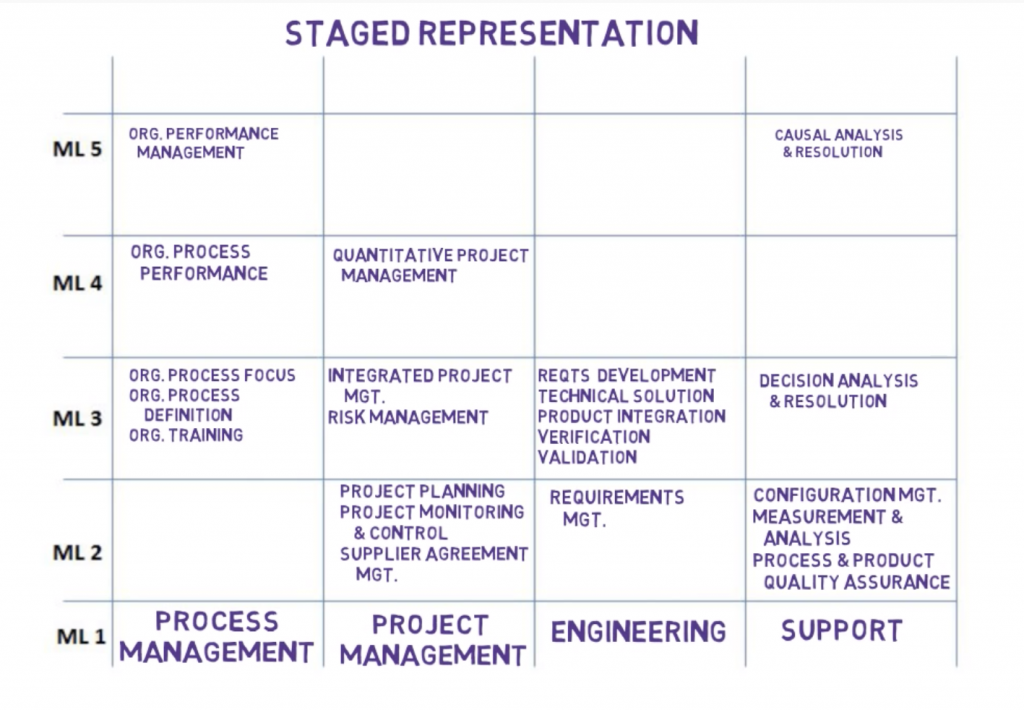
Joining the trend, we made a TikTok so that you can see some examples of companies that are at each maturity level.
Even though the goal of organizations is to reach level 5, the model is still applicable and beneficial for organizations that have achieved this maturity level. Organizations at this level are primarily focused on maintenance and improvements, and they also have the flexibility to focus on innovation and to respond to industry changes.
But the question now is: how can an organization escalate levels?
Let’s watch this video to know it!
A real example to illustrate what we are talking about…
Accenture’s U.S. Government Group, is one of the many prestigious companies that was rated by CMMI. This enterprise got a level 4, which is a considerable high level on this rating.
The Level 4 CMMI designation signifies that Accenture’s U.S. Government practice and National Security Services group consistently deliver high-quality solutions with repeatable processes, including:
- A formal, structured decision-making process, identifying the pros and cons to different approaches that provide a basis for client recommendations.
- Developing fully integrated teams that understand and work toward the client’s common goal.
- Quality-assurance reviews that contribute to the delivery of a system that meets client requirements.
- Testing and conference room pilots to validate that the new systems perform as intended.
Stanley Gutkowski, the managing partner of Accenture’s U.S. Government practice, explained one of the reasons why the CMMI impacted the enterprise´s prestige saying “This distinction demonstrates to our public-sector clients that they will receive proven commercial practices and business processes delivered by people with a depth and breadth of industry skills and experience.”
Proven results of CMMI
Apart from rating a company’s maturity process, CMMI assures the following:

To sum up…
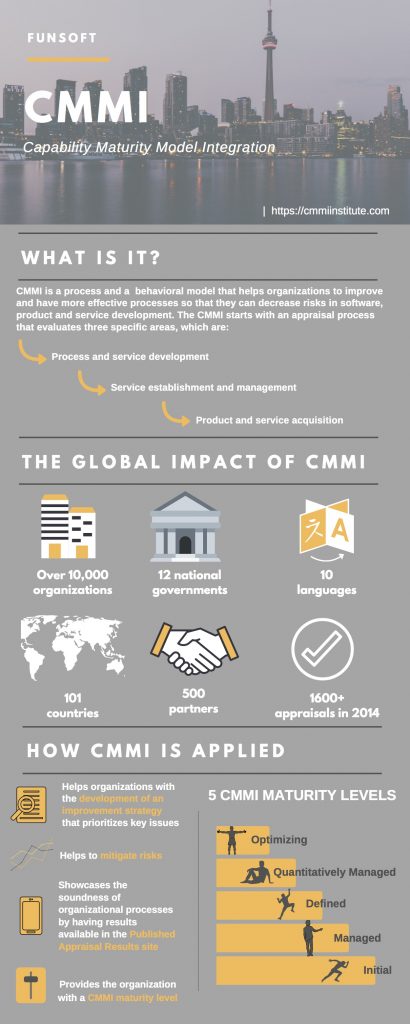
Any doubts? If you have any comments or suggestions, write it down! We are eager to hear from you.
Get to know our team!
Almudena Molina Ruiz.”I’m a Management and Technology student at UC3M. I have always been curious about business and technology and how to implement them so they can help everyone. In the future, I would love to continue learning so that I can get to work on something that I am passionate about, and that makes me happy.”
Blanca Romero Hoyos.“I consider myself an ambitious, hard-working person, really interested and dedicated to my studies, Management and Technology. I am passionate about learning and seeing how new technologies are affecting the world, and I hope one day I can contribute to this society creating value on what interests me.”
Carmen Pelayo Fernández. “Since I was little, entrepreneurship has always been one of my biggest passions. Now, that I’m studying Management&Technology at university, I’m discovering all the possibilities technology can provide us, and it’s exciting. My biggest dream is one day to be able to apply everything that I’m learning into a business project that has an impact on society and, above all, that makes me happy.”
Mónica Navas Mimiaga. “Every day I feel more and more passionate about what I study, a degree that combines both of my main interests; technology and business. I feel intrigued about many different fields such as data science or AI and hope I will learn more in the future.”
Sofía Barrera Amaral. “I am currently a student of Management & Technologies, one that loves her career because I believe it fits perfectly with my goals and the world innovation. In 5 years I see myself keeping up to date my learnings of the technological world we live in and putting them in practice in order to one day open my own company in the tech world.”
Keep yourself always updated!
Here you’ll find the all the posts and latest news published by the CMMI Institute. And if you’d also like to know even more about #DigitalBusiness, #SoftwareArchitecture and related topics, you can always follow @DBA_FUNSOFT, @carmenpelayofdz, @MolinaRuizAlmu, @Monica_Navas_, @AmaralBarrera and @blancaromeroho1 on Twitter!
References
Acuna Juan, (2018). ¿CMMI 5 qué es y quienes cuentan con este modelo? Retrieved from: https://revistacio.com/cmmi-5-que-es-y-quienes-cuentan-con-este-modelo/
Accenture, (2004). Accenture’s U.S. Government Group Achieves Level 4 CMMI Rating From Software Engineering Institute. Retrieved from: https://newsroom.accenture.com/industries/health-public-service/accentures-us-government-group-achieves-level-4-cmmi-rating-from-software-engineering-institute.htm
Broadsword, (2020). What is CMMI? Retrieved from: https://broadswordsolutions.com/what-is-cmmi/
CMMI Institute, (2020). BUILD CAPABILITY, DRIVE PERFORMANCE. Retrieved from: https://cmmiinstitute.com
CMMI Institute, (2015). CMMI Institute Capabilities. Retrieved from: https://www.youtube.com/watch?v=FzNeUFnyous
CMMI Institute, (2015). Complete list of V2.0 Appraisal Results. Retrieved from: https://sas.cmmiinstitute.com/pars/pars.pdf
CMMI Institute, (2018). Introducing CMMI V2.0. Retrieved from: https://cmmiinstitute.com/cmmi
John Maher, (2020). CMMI-DEV: Model Views and Levels. Retrieved from: https://www.youtube.com/watch?v=ErEqnPDs2Tg
John Maher, (2015). CMMI: Maturing the Organization. Retrieved from: https://www.youtube.com/watch?v=9_nO9yAzLRY
Nayely Yaline León Padilla, (2013). Ranking mundial en certificaciones CMMI-DEV ver 1.3. Retrieved from: http://pag.org.mx/index.php/PAG/article/viewFile/123/170
Software Engineering Institute, (2011). Appraisal Requirements for CMMI® Version 1.3 (ARC, V1.3). Retrieved from: https://resources.sei.cmu.edu/asset_files/TechnicalReport/2011_005_001_15383.pdf
Steven Nova, (2019). What is CMMI, and Why Does It Matter?. Retrieved from: https://novastevensville.com/what-is-cmmi-and-why-does-it-matter/
SYNC resource. CMMI Process Areas and Maturity Levels. Retrieved from: https://www.sync-resource.com/blog/cmmi-process-areas/
VideotecaQG, (2019). ¿CMMI 1.3 o 2.0?) Todo lo que necesitas considerar para tomar la decisión. Retrieved from: https://www.youtube.com/watch?v=okXQJ6vu9OE
Watts Stephen, (2020). CMMI: An Introduction to Capability Maturity Model Integration. Retrieved from: https://www.bmc.com/blogs/cmmi-capability-maturity-model-integration/
White Sarah, (2018). What is CMMI? A model for optimizing development processes. Retrieved from: https://www.cio.com/article/2437864/process-improvement-capability-maturity-model-integration-cmmi-definition-and-solutions.html
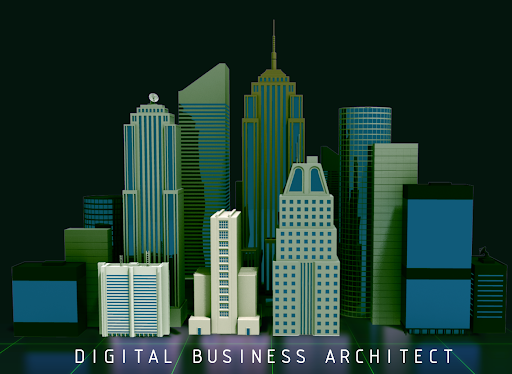
BusinessMaturity, CMMI, Innovation, ProductandServiceDevelopment, Productivity, Sustainability

Jorge Nitales
Que tik tok más chuli